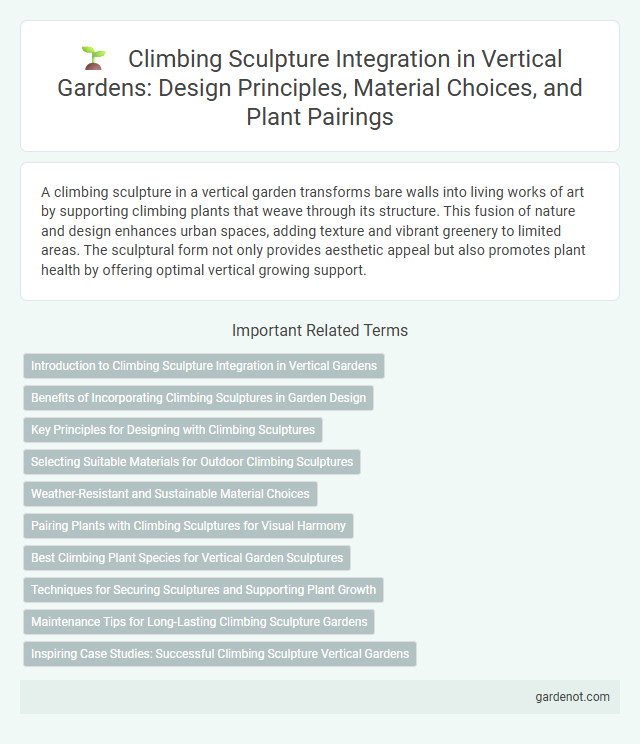A climbing sculpture in a vertical garden transforms bare walls into living works of art by supporting climbing plants that weave through its structure. This fusion of nature and design enhances urban spaces, adding texture and vibrant greenery to limited areas. The sculptural form not only provides aesthetic appeal but also promotes plant health by offering optimal vertical growing support.
Introduction to Climbing Sculpture Integration in Vertical Gardens
Climbing sculptures serve as dynamic focal points within vertical gardens, enhancing both aesthetic appeal and structural support for climbing plants. These sculptures are crafted from durable materials like wrought iron or weather-resistant metals, designed to guide vine growth while creating intricate patterns and textures. Integrating climbing sculptures promotes vertical biodiversity, optimizes space usage, and elevates the overall visual impact of urban green walls.
Benefits of Incorporating Climbing Sculptures in Garden Design
Incorporating climbing sculptures in vertical gardens enhances aesthetic appeal by creating dynamic, three-dimensional focal points that support plant growth and add texture. These structures promote vertical greenery, optimizing limited space and improving air quality through increased foliage coverage. Climbing sculptures also provide habitat for beneficial insects and contribute to environmental sustainability by reducing heat absorption on walls.
Key Principles for Designing with Climbing Sculptures
Climbing sculptures in vertical gardens require careful consideration of structural integrity, ensuring they support both the sculpture and plant growth effectively. Selecting durable materials resistant to weather and moisture enhances longevity and sustains aesthetic appeal. Integrating plant species with compatible growth habits promotes harmonious interaction between the sculpture and vegetation, optimizing overall design impact.
Selecting Suitable Materials for Outdoor Climbing Sculptures
Choosing suitable materials for outdoor climbing sculptures is essential to ensure durability and safety in vertical gardens. Weather-resistant metals like stainless steel and powder-coated aluminum offer strong structural integrity and corrosion resistance, while treated wood and fiberglass provide aesthetic appeal with added protection against moisture and UV exposure. Proper material selection enhances the sculpture's longevity and supports healthy plant growth on vertical surfaces.
Weather-Resistant and Sustainable Material Choices
Climbing sculptures in vertical gardens utilize weather-resistant materials such as powder-coated steel and treated hardwood to ensure durability against rain, wind, and UV exposure. Sustainable choices like recycled metals and FSC-certified wood enhance environmental responsibility while maintaining structural integrity. These materials provide long-lasting support for climbing plants, promoting growth and aesthetic appeal throughout changing seasons.
Pairing Plants with Climbing Sculptures for Visual Harmony
Pairing plants with climbing sculptures requires selecting species with complementary growth patterns and textures to enhance visual harmony. Vining plants like jasmine or clematis entwine gracefully around metal or wooden structures, emphasizing sculptural lines and adding dynamic movement. Combining foliage with flowering climbers creates balanced contrast, elevating the vertical garden's aesthetic and structural depth.
Best Climbing Plant Species for Vertical Garden Sculptures
Best climbing plant species for vertical garden sculptures include English ivy (Hedera helix), which offers dense, evergreen foliage for year-round coverage, and Clematis, known for its vibrant, large flowers that enhance artistic appeal. Jasmine (Jasminum) adds fragrant blooms and rapid growth, making it ideal for sculptural designs requiring quick establishment. Wisteria provides cascading clusters of purple or white blossoms, combining aesthetic beauty with robust climbing ability to create striking vertical green art.
Techniques for Securing Sculptures and Supporting Plant Growth
Climbing sculptures in vertical gardens require robust anchoring techniques such as stainless steel brackets or tensioned cables to ensure stability against wind and weight. Incorporating modular trellis systems enables flexible support for diverse climbing plants, promoting even growth and enhancing structural integration. Utilizing lightweight, weather-resistant materials minimizes stress on walls while providing optimal airflow and light exposure for healthy plant development.
Maintenance Tips for Long-Lasting Climbing Sculpture Gardens
Regular pruning and inspection prevent overgrowth and structural damage to climbing sculptures, ensuring their longevity in vertical gardens. Use corrosion-resistant materials for the sculpture and apply protective coatings to withstand outdoor weather conditions. Consistent watering and nutrient supply tailored to both the plants and the sculpture's material promote healthy growth and preserve aesthetic appeal.
Inspiring Case Studies: Successful Climbing Sculpture Vertical Gardens
Successful climbing sculpture vertical gardens demonstrate innovative integration of art and horticulture, transforming urban spaces into vibrant ecological landmarks. Notable examples include Patrick Blanc's living wall installations, which utilize modular panels and native plant species to create dynamic vertical ecosystems. These inspiring case studies highlight the potential for climbing sculptures to enhance biodiversity, improve air quality, and elevate aesthetic appeal in densely populated environments.
Climbing sculpture Infographic

 gardenot.com
gardenot.com